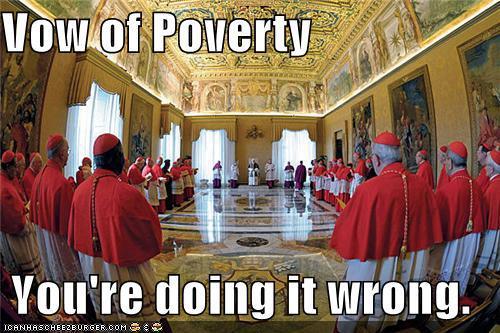In Defense of Nice Churches
by Marc Barnes
Filed under The Church
At some point in discussions between Catholics and atheists, the Catholic is obliged to defend the flair his Church has for covering everything in gold.
The criticism, veiled as a question, isn’t without foundation. There have been all manners of abuse regarding wealth within the Church, and — if I may prophesy — there will continue to be. No sane man would defend the personal hoarding of wealth, especially not among clergymen. But when the man outside of the Church bemoans the unsold wealth of the Church, he’s not thinking of crooked cardinals or Popes parading as Renaissance princes. He is thinking of the cathedrals and the basilicas, the thrones and tabernacles of gold, the chalices of sliver and the jewel-encrusted robes, the pomp and pageantry of the largest human institution in the world. Hence:

To summarize the modern axiom: The Catholic Church has gold and refuses to sell it, thus the Church lets the poor starve.
It’s a noble complaint, but the reality is this: The Church’s wealth comes from the poor. What people miss when they speak of “The Catholic Church” — and by it mean a few cardinals, bishops, and a Pope — is that the Catholic Church is made up of every Catholic, rich and poor alike. Thus the upkeep and general wealth of the Church comes from every member of the Church, rich and poor alike, giving to their respective dioceses. As a college student who has put his laughable dollar into the collection plate more than twice, I can attest to this fact.
But most importantly — and this really is my point here — the wealth of the Church exists for the edification and benefit of every Catholic. Cathedrals are not solely for bishops. A throne exists for more than the man sitting on it. It is a certain nasty pride that tells the man suffering from poverty that the Beauty surrounding him — be he a homeless man appreciating the cool of St. Patrick’s Cathedral in New York, or a Haitian saying prayers in the Cathédrale St. Jacques et St. Philippe — that it should all be torn down, sold, and given to him in the form of money. It is an offense to say, “this golden tabernacle you kneel before — it should be melted for bread.” The poor man in this position would do well to tell his well-intentioned but misguided friend the truth that “man does not live on bread alone.”
Faulting the Cathedrals and Basilicas of the world for containing “too much” wealth is an awkward denial of the fact that the cathedrals and basilicas of the world are explicitly for the use of the poor, and to steal from them is to steal, not merely from the Church, but from the poor themselves — the poor who, despite the perceptions of Hollywood, do not merely need bread, cash, and contraception, but beauty, ritual, and God as well.
In sum: the visible wealth — the very stuff that sets people complaining — is for the poor.
But surely the cardinals and Popes are rolling in it. Right? I can’t speak for the entire world, but the average salary of an American bishop is $23,ooo per year, about half the average American’s. The average priest’s is $40,000 per year, only $20,000 of which is actually “take home cash”. And if you’re the Pope, not only does your salary suck, but you don’t get it until you’re dead. Popes get one gold, silver, and copper coin for each year of service placed on their coffin. Blessed John Paul II received about $141 dollars.
We should note that when many people criticize the Church's extravagant architecture and art, they often invoke Jesus. Let's examine his response to a similar criticism:
“While Jesus was in Bethany, a woman came to him with an alabaster jar of very expensive perfume, which she poured on his head. When the disciples saw this, they were indignant. “Why this waste?” they asked. “This perfume could have been sold at a high price and the money given to the poor.”
Aware of this, Jesus said to them, “Why are you bothering this woman? She has done a beautiful thing to me. The poor you will always have with you, but you will not always have me. When she poured this perfume on my body, she did it to prepare me for burial. I tell you the truth, wherever this gospel is preached throughout the world, what she has done will also be told, in memory of her.”
Here Jesus welcomes and praises the excessive love poured out for him — what Judas calls "waste." But that's precisely what Catholics continue doing today. Atheists must remember that Catholics believe the words of Christ, that in the Mass he becomes bread for us, transforming mere wheat and wine into his Body and Blood. Thus when we build for him a tabernacle of gold, and chalices of silver, pillars of marble, and windows of fiery glass, we do it not to placate men but to honor God. God does not disdain these treasures any more than he disdained the Wise Men’s gold or the Bethany woman's perfume, for our praise is his gift to us, the spiritually poor, who by it are granted the desire for communion with him.
Related Posts
Note: Our goal is to cultivate serious and respectful dialogue. While it's OK to disagree—even encouraged!—any snarky, offensive, or off-topic comments will be deleted. Before commenting please read the Commenting Rules and Tips. If you're having trouble commenting, read the Commenting Instructions.













